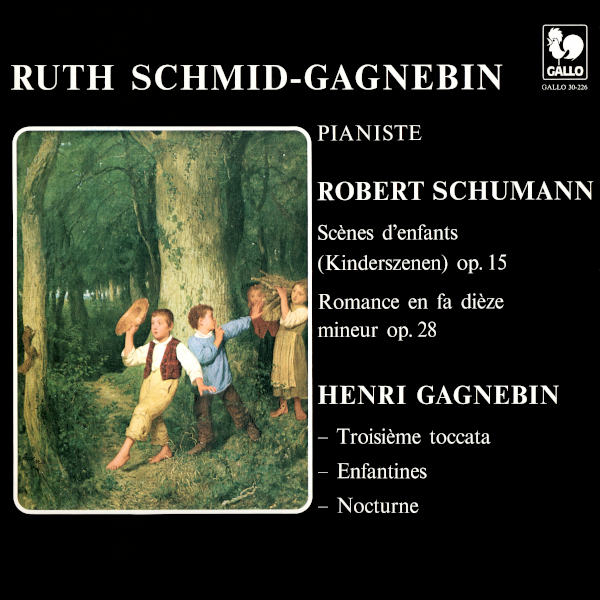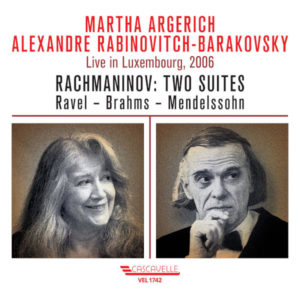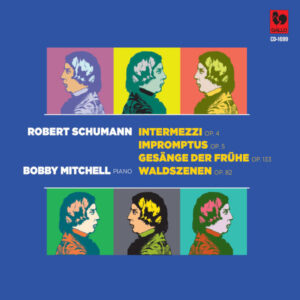Extraits / Excerpts
Schumann: Scenes from Childhood Op. 15 - Romance, Op. 28 - Gagnebin: Toccata No. 3 - Enfantines - Nocturne - Ruth Schmid-Gagnebin, Piano
Robert SCHUMANN: Scenes from Childhood Op. 15: No. 1 Von fremden Ländern und Menschen – No. 2 Kuriose Geschichte – No. 3 Hasche Mann – No. 4 Bittendes Kind – No. 5 Glückes genug – No. 6 Wichtige Begebenheit – No. 7 Träumerei – No. 8 Am Kamin – No. 9 Ritter von Steckenpferd – No. 10 Fast zu ernst – No. 11 Fürchten machen – No. 12 Kind im einschlummern – No. 13 Der Dichter spricht – Romance in F-Sharp Minor, Op. 28 – Henri GAGNEBIN: Toccata No. 3 pour piano – Enfantines: No. 1 Chanson à 2 voix – No. 2 Allégresse – No. 3 Complainte – No. 4 Encore une chanson à 2 voix – No. 5 Musique de tambour – Nocturne pour piano.
Ruth Schmid-Gagnebin, Piano.
Robert Schumann (1811-1856)
Scenes from Childhood Op. 15
It was in February 1838 that Schumann composed the pieces he called the Kinderszenen. On the 12th of that month, he wrote:
“composed pretty little things.”
On the 24th, he added:
“composed the little Reverie (Träumerei).”
He also wrote to Clara:
“You once said to me, ‘You sometimes give me the impression of being a child?’ If that’s true, you will see that this child has now grown wings. Perhaps it’s an unconscious answer. I’ve written more than 30 such little pieces and chosen 12 to group under the title Kinderszenen. I’m sure you’ll enjoy playing them, but you must forget that you are a virtuoso!”
Of course, Clara played them beautifully.
Though the title may suggest otherwise, these pieces are far from childish. Each contains a profound poetic expression that evokes scenes from childhood with great intimacy. The interpreter must make the audience forget the technical work involved—the effort behind each musical figure, the delicate phrasing, the precise accentuation—so that these small masterpieces can come to life in all their purity and subtlety.
Henri Gagnebin (1886-1977)
Born in Brussels, Henri Gagnebin was a pupil of d’Indy and Vierne in Paris. He later became a professor in Neuchâtel, Lausanne, and Geneva, where he directed the Conservatoire of Music from 1925 to 1957.
He was the Founder and President of the International Contest for Musical Execution in Geneva (1938-1959) and also the President of the Federation of International Musical Contests. This recording has been made in accordance with his instructions.
His Troisième Toccata brings to our ears the muffled chimes, whose deep, resonant notes he loved, combined with the sounds of rustic life.
Moreover, he retained vivid memories of his childhood aspirations (such as the dream of playing the drum or tambourine!). All these elements are reflected in a delightful mix of music, sometimes playful, sometimes sensitive, in his Enfantines. As for his Nocturne, he did not follow the imitators of Chopin, but expressed his poetic sensibilities in his own distinctive style.
Ruth Schmid-Gagnebin
Ruth Schmid-Gagnebin was born in Neuchâtel (Switzerland) in 1921. She studied music in Zurich, Lausanne, Geneva, and Paris, entering a tradition of expressive clarity and poetry. A Milanese critic once wrote about her performance in L’Italia: “La sua arte è raffinata, variata e graduata, con tutti gli accorgimenti dello stile“. Similarly, in Basel’s National Zeitung: “Ihr Spiel hinterliess einen nachhaltigen Eindruck, denn die Meisterschülerin von Dinu Lipatti verfügt über eine stupende Gewandtheit.”
In Germany, her interpretations of Debussy were particularly appreciated. In Cologne, the renowned critic Wiederbusch wrote in the Neue Rheinzeitung: “Sie scheint prädestiniert für die sensible Zartheit dieser Traumvisionen und brachte in flimmernd-fliessenden Tönen das Geheimnisvoll-Unwägbare zum Ausdruck. Die Ausbrüche des Tänzerisch-Bewegten gestaltete sie mit überzeugender Rhythmik und klarer Akzentuierung.”
During the past winter, she performed in six different Swiss cities, including Zurich (Tonhalle) and Vevey (Grand-Théâtre). Critics praised her presence: “weist sich manuell wie gestalterisch aus” (ZH-TgB.J.S.) and her conviction: “mit innerer Überzeugung und Verbundenheit“, noting: “Ein in Spannungsbogen packender Abend.” She recorded the 24 Etudes op. 10 and op. 25 of Chopin.
Regarding her performances of Liszt, critics remarked: “Une pianiste qui excelle dans la virtuosité du romantisme.” After the release of her recordings of Debussy’s Préludes, Ruth Schmid-Gagnebin lived part-time in Switzerland and part-time in New York, where Debussy’s works experienced a renewed interest.
- Categories
- Composers
- Interprets
- Booklet












